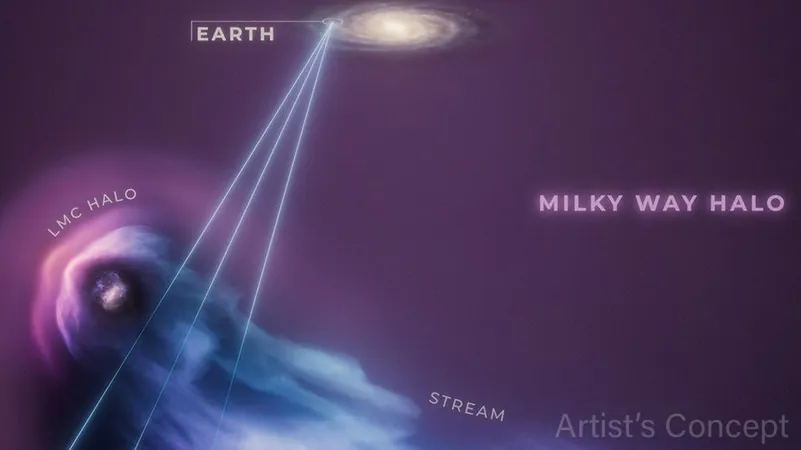
Milky Way's Cosmic Bulliness: How It Stripped the Large Magellanic Cloud's Gas
2024-11-18
Author: Yu
Introduction
In the vast expanse of our universe, the Milky Way stands tall as a dominant force, often overshadowing its smaller cosmic neighbors. Among these, the Large Magellanic Cloud (LMC) and the Small Magellanic Cloud (SMC) are the two dwarf galaxies most closely entwined with our own. Although these satellites are considerably smaller— with the LMC possessing only about 10% of the Milky Way's mass—they are at the mercy of our galaxy's gravitational influence.
Groundbreaking Study
A recent groundbreaking study using data from the Hubble Space Telescope has reinforced the Milky Way's reputation as a cosmic heavyweight. This research highlights that the gas halo surrounding the LMC is approximately ten times smaller than that of similar-sized galaxies, suggesting that our Milky Way has previously siphoned off a significant amount of the LMC's material.
Hubble's Observations
Hubble's cutting-edge ultraviolet observations provided the basis for this insightful revelation. Andrew Fox, principal investigator from AURA/STScI for the European Space Agency, stated, “The LMC is a survivor. Even though it's lost a lot of its gas, it retains enough to continue forming new stars. Other smaller galaxies wouldn’t have endured this loss; they would have simply faded into clusters of aging red stars.”
Survival of the LMC
Despite the harsh realities of cosmic bullying, the LMC has managed to cling to a vital reservoir of gas. This remaining material is crucial in keeping the sparks of star formation alive within the galaxy. Utilizing innovative techniques, researchers observed the LMC's gas halo by examining the light absorbed from 28 distant, bright quasars—acting like cosmic lighthouses illuminating the darker territories of space.
Research Techniques
“We utilized Hubble's Cosmic Origins Spectrograph (COS) to dissect the quasars' light, unveiling essential characteristics of the halo's gas, including its temperature, velocity, and composition,” explained Sapna Mishra, the lead author of the study.
Cosmic Interplay
This cosmic interplay between the LMC and the Milky Way provides essential insights into the evolution of galaxies. As researchers delve deeper into these observations, they aim to unveil the complex dynamics that played a role in the early universe when galaxies were densely packed and frequently interacted.
Future Research
Looking ahead, scientists plan to expand their exploration. “In our upcoming research, we will examine five locations where the LMC's halo meets the Milky Way's halo,” said Scott Lucchini, a co-author of the study. “This interaction represents a fascinating compression of two galactic halos, akin to two balloons squishing against each other.”
Conclusion
The findings not only illuminate the gravitational ballet between galaxies but also remind us that even in the grand tapestry of the cosmos, survival often hinges on the ability to adapt to overwhelming forces. What mysteries will the stars reveal next? Stay tuned for more groundbreaking discoveries!
 Brasil (PT)
Brasil (PT)
 Canada (EN)
Canada (EN)
 Chile (ES)
Chile (ES)
 España (ES)
España (ES)
 France (FR)
France (FR)
 Hong Kong (EN)
Hong Kong (EN)
 Italia (IT)
Italia (IT)
 日本 (JA)
日本 (JA)
 Magyarország (HU)
Magyarország (HU)
 Norge (NO)
Norge (NO)
 Polska (PL)
Polska (PL)
 Schweiz (DE)
Schweiz (DE)
 Singapore (EN)
Singapore (EN)
 Sverige (SV)
Sverige (SV)
 Suomi (FI)
Suomi (FI)
 Türkiye (TR)
Türkiye (TR)